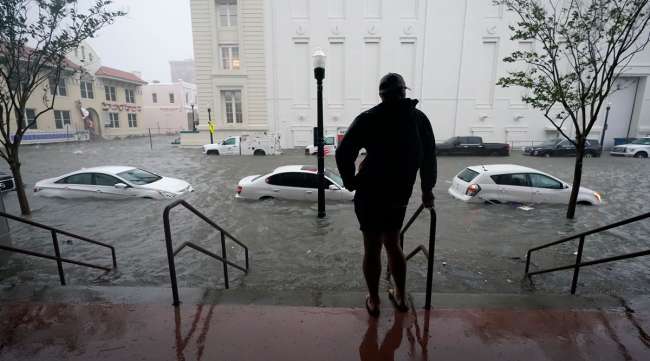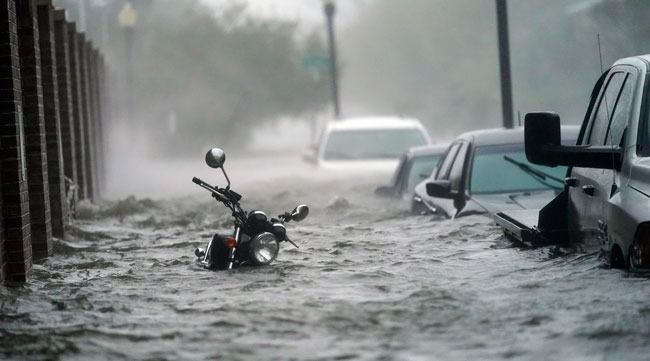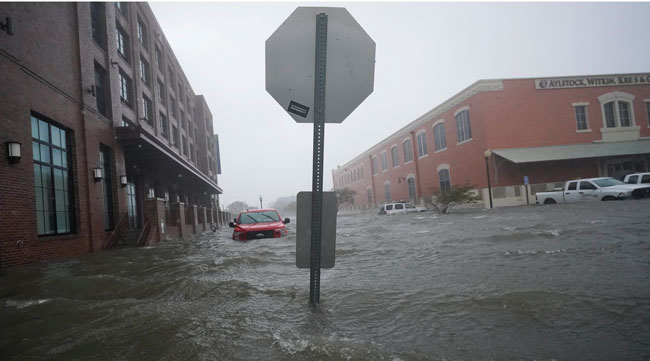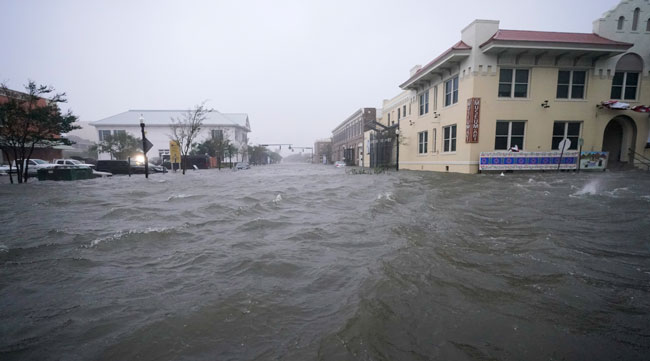Hurricane Sally Unleashes Flooding Along the Gulf Coast

[Ensure you have all the info you need in these unprecedented times. Subscribe now.]
PENSACOLA, Fla. — Hurricane Sally lumbered ashore in Alabama with 105 mph winds and torrential rain Sept. 16, swamping homes and trapping people in high water along the Gulf Coast as it crept inland for what could be a long, slow and disastrous drenching across the Deep South.
Moving at an agonizing 3 mph, or about as fast as a person can walk, the storm made landfall at 4:45 a.m. near Gulf Shores after raking the coast for hours from Pensacola Beach, Fla., westward to Dauphin Island, Ala.
Emergency officials in Alabama and Florida reported flash floods that pushed water into homes. More than 2 feet of rain was recorded near Naval Air Station Pensacola, and the National Weather Service reported nearly 3 feet of water covered streets in downtown Pensacola.
“It’s not common that you start measuring rainfall in feet,” National Weather Service forecaster David Eversole said in Mobile, Ala. “Sally’s moving so slowly, so it just keeps pounding and pounding and pounding the area with tropical rain and just powerful winds. It’s just a nightmare.”

Flood waters from Hurricane Sally move on the street Sept. 16 in Pensacola, Fla. (Gerald Herbert/Associated Press)
It was the second hurricane to hit the Gulf Coast in less than three weeks and the latest blow in one of the busiest hurricane seasons recorded, so frenetic that forecasters have nearly run through the alphabet of storm names with 2½ months still to go. At the start of the week, Sally was one of a record-tying five storms churning simultaneously in the Atlantic, strung out like charms on a bracelet.
Like the wildfires raging on the West Coast, the onslaught of hurricanes has focused attention on climate change, which scientists say is causing slower, rainier, more powerful and more destructive storms.
In Orange Beach, Ala., at least 50 people were rescued from flooded homes and taken to shelters, Mayor Tony Kennon said.
“We got a few people that we just haven’t been able to get to because the water is so high,” Kennon said. “But they are safe in their home, as soon as the water recedes, we will rescue them.”
Street lights were knocked out in downtown Mobile, where a stoplight snapped, swinging wildly on its cable. Trees were bent over as the rain blew sideways in the howling wind. In downtown Pensacola, car alarms went off, the flashing lights illuminating the floodwaters surrounding parked cars.

In Pensacola, Fla., flood waters from Hurricane Sally rise up a stop sign on Sept. 16. (Gerald Herbert/Associated Press)
Before sunrise, water was up to the doors of Jordan Muse’s car outside the Pensacola hotel where her family took shelter after fleeing their mobile home a few miles away. The power failed early in the morning, making it too stuffy to sleep. Her 8-year-old son played with toys underneath the hotel room’s desk as Muse peered out the window, watching rain fly by in sheets.
“The power trucks are the only ones above water, and they’re the biggest,” Muse said. “I can’t believe it got so bad. That’s why we came here.”
Nearly a half-million homes and businesses had lost electricity by early Sept. 16, according to the poweroutage.us site. A curfew was imposed in Gulf Shores hours before the storm’s arrival. Florida officials shut down a section of Interstate 10 near Pensacola because of high winds.
In the Panhandle’s Escambia County, Chief Sheriff’s Deputy Chip Simmons vowed to keep deputies out helping residents as long as possible. The county includes Pensacola, one of the biggest cities on the Gulf Coast.
“The sheriff’s office will be there until we can no longer safely be out there, and then and only then will we pull our deputies in,” Simmons said late Sept. 15.

Flood waters from Hurricane Sally crept up buildings in Pensacola, Fla., on Sept. 16. (Gerald Herbert/Associated Press)
This for a storm that, during the weekend, appeared to be headed for New Orleans, about 200 miles to the west.
“Obviously this shows what we’ve known for a long time with storms — they are unpredictable,” Pensacola Mayor Grover Robinson IV said.
National Hurricane Center forecaster Stacy Stewart said the rain will be “catastrophic and life-threatening” over portions of the Gulf Coast.
The storm still had winds of 100 mph more than two hours after it reached land. Forecasters warned that heavy rainfall would continue into Sept. 17 as the storm moved inland over Alabama and into central Georgia, with the threat of serious flash flooding.
“Sally has a characteristic that isn’t often seen and that’s a slow forward speed, and that’s going to exacerbate the flooding,” said Ed Rappaport, deputy director of the hurricane center.
This is an example of the many dangers flash flooding presents. This image was taken in Walton County, illustrating the tremendous force of water washing out a bridge on Bob Sikes past Corbin Gainey. https://t.co/P3svDxi1qx — NWS Tallahassee (@NWSTallahassee) September 16, 2020
He likened the storm’s plodding pace to that of Hurricane Harvey, which swamped Houston in 2017.
Sally’s effects were felt all along the northern Gulf Coast. Low-lying properties in southeastern Louisiana were swamped by the surge. Water covered Mississippi beaches and parts of the highway that runs parallel to them. Two large casino boats broke loose from a dock where they were undergoing construction work in Alabama.
In Orange Beach, Ala., Chris Parks, a tourist from Nashua, N.H., spent the night monitoring the storm and taking care of his infant child as the winds battered his family’s hotel room. Their return flight home was canceled, so they were stuck in Alabama until Sept. 18.
“I’m just glad we are together,” Parks said. “The wind is crazy. You can hear solid heavy objects blowing through the air and hitting the building.”
As Sally’s outer bands reached the Gulf Coast, Tom Parker, manager of an alligator ranch in Moss Point, Miss., hoped he wouldn’t see a repeat of what happened at the gator farm in 2005, when about 250 alligators escaped their enclosures during Hurricane Katrina’s storm surge.
President Donald Trump issued emergency declarations for parts of Florida, Alabama, Mississippi and Louisiana.
Sally hit just shy of three weeks after Hurricane Laura pummeled southwestern Louisiana on Aug. 27. Thousands of people are still without power from that storm, and some are still in shelters.
Meanwhile, far out in the Atlantic, Tropical Storm Teddy became a hurricane with winds of 100 mph. It was situated more than 800 miles east of the Lesser Antilles. Forecasters said it was likely to become a major hurricane and could reach Category 4 strength Sept. 17.
Jay Reeves, Angie Wang and Jeff Martin were the primary contributors to this report.
Want more news? Listen to today's daily briefing:
Subscribe: Apple Podcasts | Spotify | Amazon Alexa | Google Assistant | More

